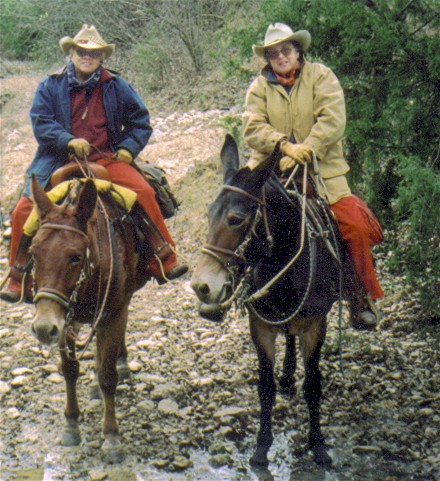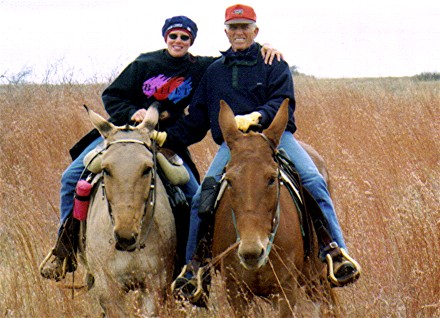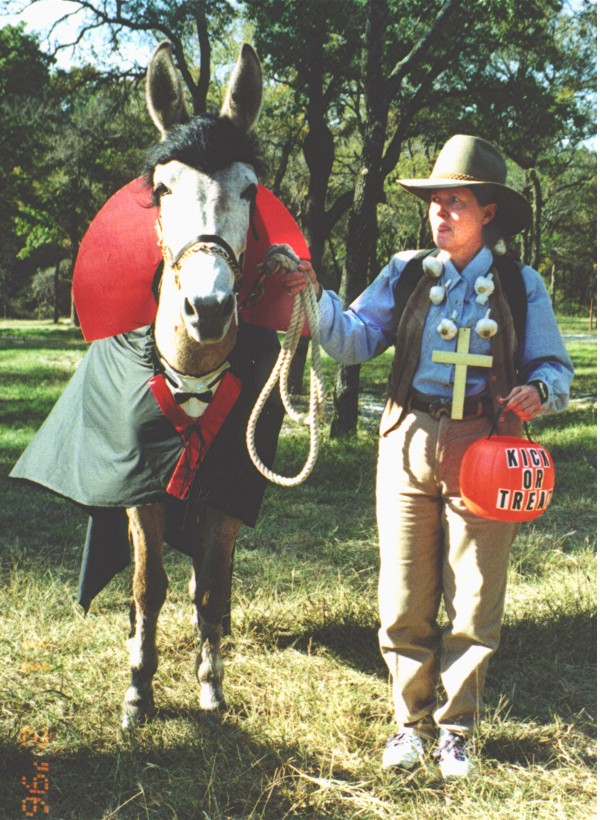|
CROSS-TRAINING THE MULE ATHLETE by Tex Low Windy Hill Endurance Mules |
|
Overcoming Boredom, Resistance and Belligerence |
| With the increased emphasis on sports today, there is much talk
about and many articles written on the subject of cross-training--
for humans, that is! But only recently are we beginning to see in
print information related to the pros and cons of cross-training for
the equine athlete. And, as usual, the articles are focused on
horses; mules being the eternal stepchildren of equinedom. Having
been in the Arabian horse business before I saw the light and
switched to mules, I experienced first hand what havoc repetition
and boredom can wreak with a training program, no matter how
well-designed. The more intelligent the animal, the more resistant
and/or downright belligerent they become when daily training
routines are monotonous. Since Arabians are the most intelligent of
the horse breeds, and mules are so far ahead of them in the brain
department, I have had a lot of experience dealing with the battle
of wills that result when your equine has been there, done that, and
refuses to do that again!
Of course, these negative reactions on the part of your equine partner make for a less-than-positive attitude on your part when you contemplate the upcoming ride or training session. Then you feel guilty, knowing that the goals you have set for your animal and yourself are certainly NOT going to be accomplished by avoiding the issue. The vicious cycle begins here. You dread working your mule. You go ahead and work anyway. Your animal senses your negativity and the battle begins--ears back, tail swishing, stiff gaits, weight on the front end, etc. You lose your temper. Your animal balks. Sound familiar? But if you donít work, you feel depressed and are afraid you will do poorly in your upcoming competition. Damned if you do and damned if you donít! So whatís the solution? Here are some suggestions that I have found to put variety and interest back in your workouts and training sessions--for your mule and yourself. CHANGE OF ENVIRONMENT
The first step is to change your training environment. Get out of the round pen, arena, or riding ring and into the real world--woods, trails, off-road terrain, beaches, natural obstacles, even just out in the pasture. Now, if your mule is primarily a show animal whose world is comprised of stalls and arenas, this back-to-nature approach will take some getting used to. Several years ago, my Arabian endurance mule was three and had just returned from the trainer after being put under saddle. I was trail riding with a friend of mine who had also just gotten their three-year-old back from the trainer. Here all similarity ended! We were riding in fairly heavy timber, over fallen trees and logs, through heavy brush and brambles, crossing ravines and creek beds (with and without water). I say we. Actually, the only we applied to my mule and myself. It turned out to be a lengthy babysitting situation in regards to my friendís mule, who, being a show mule, had been exposed only to her home pasture and barn and the trainerís arena. Every shadow/bush/log was a booger. Vines and brambles were vicious tentacles, to be avoided at ANY cost, including dumping her rider. The first creek bed was dry, so it only took fifteen minutes and four trips by my mule crossing and returning to convince my friends show mule that she really could put her heads down, get her rear end up under her, slide down the crumbling sand bank and scramble up the other side.... and live to tell about it! Creek beds with water, especially running water were a MAJOR challenge. Forty-five minutes, fifteen crossings and re-crossings by my mule, two dumpings of my friend, and several words that I will not print here were invested in the first creek fording. The next five crossings were progressively less traumatic--for the mule and her muddy, disheveled rider. When we finally got back to the trailers, we had a lively discussion about how differently our mules had handled the terrain and obstacles. Sure, her mule could side pass, turn on the forehand, and had the perfect show headset; talents my mule would not possess until later in her career. But my mule (at my request) had been trained in the woods, river bottoms, hills, and sand washes by an old cowboy who doesnít even have an arena. I do not show, nor do I ever plan to. Endurance riding competition is my passion in life, ranking only behind mules. My endurance mule would have probably reacted in a show arena much the same as my friendís show mule behaved out in the woods on trail. Itís all in what they get used to. The first time you go out in strange territory, it would be best to go with another rider whose horse or mule is an old hand at whatever you are about to experience--be it creeks, traffic, or loud machinery. You and your mule will enjoy and benefit from the change of scenery much more if you have the calming influence of a companion. As soon as your animal becomes accustomed to the new surroundings and terrain, you can venture out by yourself without an escort.
Use what nature has to offer to enhance your workouts. The woods offer endless possibilities and natural equipment. Cavaletti are great tools to teach your animal to lengthen its stride, pay closer attention to where its feet are and be more balanced in its way of going, no matter what the discipline. Fallen tree limbs and small downed trees make great cavaletti. The undergrowth and unevenness of the ground will cause your flatland mule to perk up and pay close attention to the terrain and to your commands, lest it stumble. Larger felled trees and logs can be used for obstacle practice, or jumping, as long as you walk carefully over them the first time and check the footing on the other side. Weaving in and out of closely spaced saplings and trees provides an excellent opportunity to practice/reinforce leg cues and fine tune reining. If possible, find a place to ride with inclines--hills, valleys, mountains, anything that will provide opportunity for your mule to learn how to use its rear end on more challenging terrain. Going downhill teaches the animal to move up under itself to maintain proper balance and increases the muscling in the rear end--great for halter classes and much more interesting than longeing or backing. Itís also a great way to slow down a mule that wants to charge into everything. The mules strong sense of preservation will kick in when faced with challenging terrain. This will get their attention better than any exercise you could devise in an arena. Remember to help your mule on inclined surfaces by leaning forward slightly going uphill and backward slightly when going downhill. Beach riding, for those lucky enough to live close to the ocean, is super for legging up your mule, providing you get them used to moving in sand gradually, strengthening the tendons and ligaments before you increase either speed or distance. Once they have some base of sand conditioning on their legs, climbing and descending sand dunes really toughens up and tones the leg muscles and builds up their wind. This is especially effective for timed event mules--barrels, poles, keyhole, etc. They will suffer fewer leg problems and charge less if conditioned in this manner. It also keeps them form becoming arena sour from too much ring riding. IF (and I do mean IF) your mule will do it, swimming in the surf is great exercise. It provides resistance to build strength and muscle, without putting weight stress on the legs. It is especially effective when trying to bring an animal back from an injury or being laid off. Swimming in a lake or stock pond will accomplish much the same thing, without having the sand for leg work. As with anything out of the ordinary for a mule, some will and some wont! Going with another rider whose mount is an old hand at this swimming stuff will help, but be prepared for a quick trip away from the waterís edge, especially if the tide is rolling in with whitecaps.
CHANGE OF ROUTINE Again, when the natural environment has done its work to soothe and refocus your mule and made your training a more positive experience for both of you, its time to consider how you can alter your training schedule and routine to offer a new look and feel to yourself and your animal. My method of accomplishing this change is engage the mule in activities that are totally unrelated to what the animal does primarily for a living--a different scenario, but one that contributes to your overall goal. Case in point: my mule does endurance competition for a living. Training her in a natural environment is NOT a change of routine, as it would be for a show animal. So when I needed her to lengthen her stride and extend her trot to be more competitive at the rides, I sent her to a friend of mine who trains dressage Arabians. We have this great swap going. She sends me her Arabians who are stressed out from the tedium of dressage to ride in the woods, marking trail for endurance rides or just for pleasure. I send her my endurance animals who need work on stride, extension, balance, flexibility, etc. This wonderful arrangement is actually what gave me the original idea to write this article. Now I will admit that she was just a wee bit skeptical about taking my mule for dressage training, having never been near mules, much less ridden one. Okay, so her exact words were, Youíre kidding, right? I mean, mules canít do dressage, can they? I then showed her pictures of Hunter Mountain Banjo (Cindy Powell up) and the incomparable Squawlena, being ridden by Diann Walker, both performing in a dressage class at a show. At that point she was willing to admit it was possible, but still wasnít totally convinced. When I refused to take no for an answer, she reluctantly agreed to take her--on a two week trial basis. But I wasnít worried. I knew that this woman appreciated a quick mind and a willing attitude, both of which my mule possesses in great abundance. Almost two weeks had passed since I dropped my mule off at the trainers. Every day when I got home from work, I checked by messages and E-mail, assuming to hear Come get your !#*/ mule! I hoped no news was good news. Another week passed. I feared perhaps they had killed each other. On the twenty-third day, the trainer called to ask if she could take my mule to her weekly advanced dressage lesson with this German woman. YES!!! Secretly I was gloating, but tried to sound just a little surprised. The trainers first comment after I gave her permission to take the mule to her instructor was, It took your mule about thirty minutes to figure out a movement I had been working on with my Arab gelding for three days!! She was a convert! Has an Arabian dressage mare she is going to breed to a mammoth jack? Tells everyone about how fast mules catch on and how stubborn they are...NOT. Has already asked if she can train my yet unborn mule out of my Arabian endurance mare. Takes major flack from her dressage friends and just laughs it off. I love it! But the best part was that the arena work with cavaletti,
spirals, circles, longeing, etc. worked. On my last endurance ride,
my mule covered 30 miles of nothing but rock in the Hill Country
near Uvalde in less than five hours, including a 45 minute vet check
hold. Who would have thought that dressage training CHANGE OF ATTITUDE Practicing the same thing over and over in the same way, in the same place, in the same order is a bummer for yourself and your mule. The mule will tune you and your commands out long before you realize how boring the routine has become. So my hope is that you will take this information to heart and perhaps avoid the pitfalls of having to deal with an animal that does not enjoy what is doing and who it is doing it with. I can tell you that it has always worked for me. I do not claim to be an expert, but only write of what I know about. Take the charge out of a timed event mule by riding it in a mounted drill team? Go on an outfitter expedition with your arena-sour, burned out western pleasure mount? Teach your bored stiff halter mule how to rope or team pen? You bet!! Variety is the spice of life--for people and animals. Be brave. Try something totally radical. You will be pleasantly surprised---and pleased with the results.
|
 You
will be amazed at what effect just changing scenery will have on
your mule and yourself. I have seen some totally arena-sour animals
change their perspective on the world by just being exposed to
Mother Nature. At first, just pleasure ride for fun. After a few
outings, as your mule relaxes, drops its head and rounds out its
back, comfortable in its surroundings; you can actually work on many
fairly intricate training concepts in natural surroundings
You
will be amazed at what effect just changing scenery will have on
your mule and yourself. I have seen some totally arena-sour animals
change their perspective on the world by just being exposed to
Mother Nature. At first, just pleasure ride for fun. After a few
outings, as your mule relaxes, drops its head and rounds out its
back, comfortable in its surroundings; you can actually work on many
fairly intricate training concepts in natural surroundings I
canít stress too strongly to those of you who show (English,
western, trail, dressage, reining, etc.) or participate in timed
event competitions--anything in an arena--how imperative it is to
get out of that sterile environment and give your mule something
that requires paying attention to! Your animal needs to wonder what
will happen next, what might appear around the next tree, how the
footing may differ in the next few yards--challenging the animal to
use the fine mind and quick reflexes that it possesses. I guarantee
that if you donít keep that agile mind and body occupied, your mule
will be happy to oblige, usually to your embarrassment and everyone
elseís amusement. Remember, the unchallenged mind and body of a mule
is a scary thing to contemplate.
I
canít stress too strongly to those of you who show (English,
western, trail, dressage, reining, etc.) or participate in timed
event competitions--anything in an arena--how imperative it is to
get out of that sterile environment and give your mule something
that requires paying attention to! Your animal needs to wonder what
will happen next, what might appear around the next tree, how the
footing may differ in the next few yards--challenging the animal to
use the fine mind and quick reflexes that it possesses. I guarantee
that if you donít keep that agile mind and body occupied, your mule
will be happy to oblige, usually to your embarrassment and everyone
elseís amusement. Remember, the unchallenged mind and body of a mule
is a scary thing to contemplate. could have improved an endurance mounts performance?
could have improved an endurance mounts performance?